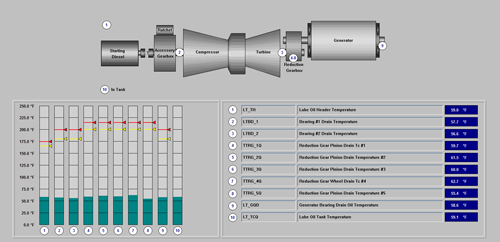The TMS-1000 Series of turbine controllers are built on the most advanced programmable controller platforms available today—these systems are designed using the latest in distributed control philosophy. With our hardware independent approach, one can use technology and parts already common to their plant.
Benefits
- Improving existing control system performance and reliability
- Optimizing unit output and efficiency
- Eliminating dependence on the OEM for spare parts and/or repair
- Reducing the cost of spare parts and/or repair
- Improving the amount and quality of information the system provides to operators and engineers
- Providing additional features to enhance unit operation and maintenance
System Overview
The TMS Series™ 1000 Turbine Control System (TMS-1000) is a digital control system designed to provide enhanced control and protection for the Gas Turbine train while maintaining the original system functionality.
TTS utilizes Rockwell Automation’s ControlLogix platform, which offers the user a high-speed, high-performance system. The controllers perform all of the sequencing, fuel control and protection that is necessary for proper gas turbine operation.
The TMS-1000 system is available for use on all Heavy Duty Industrial and Aeroderivative Gas Turbine models and is intended to replace legacy analog and digital control systems.
System Architecture
Controller Configuration
The standard TMS-1000 system is equipped with redundant Rockwell Automation ControlLogix Programmable Automation Controllers (PAC) providing bumpless switchover and high availability. This is achieved by using a redundant chassis pair and redundancy modules in each chassis.

The redundancy modules monitor events that occur in each redundant chassis and initiate the system response to events that require it. One chassis is configured as Primary, responsible for controlling the redundant system; the other chassis is configured as Secondary, ready to assume control if needed.
Programmable Automation Controller (PAC) features
- TUV SIL2 Certification
- Redundancy
- Multiple Communication Modules
- Memory Sizes Ranging from 750KB to 32MB
- RIUP (Removal and Installation of Modules Under Power)
- Built in Floating Point Math Co-Processor
- Can Be Used in the Same System/Chassis as the TUV SIL3 Certified GuardLogix Controllers
Network Configuration
An Ethernet/IP network is utilized for HMI communications. Ethernet modules are placed in each chassis of the redundant pair, bridging data communications from the controllers to the operator interface(s).
The I/O communications network implements a redundant ControlNet configuration. Redundant ControlNet modules are placed in each chassis of the redundant pair and in all I/O nodes. The modules are connected together with redundant co-axial cables that extend the I/O communications bus from the I/O module level back to the PACs.
I/O Configuration
The ControlLogix™ product line provides a wide range of input and output modules to span many applications, from high-speed digital to process control.
All I/O modules are industrial quality and are designed to withstand vibration, temperature and electrical noise common to gas turbine environments. The standard I/O configuration implements ControlLogix I/O modules for Discrete Inputs, Discrete Outputs, Analog Inputs and Analog Outputs.
Non-critical field devices wire directly to single I/O modules and the critical field devices (TMR) distribute to triplicate I/O modules. This approach to TMR allows the control system to tolerate the failure of any critical field device, as well as any critical I/O module.
